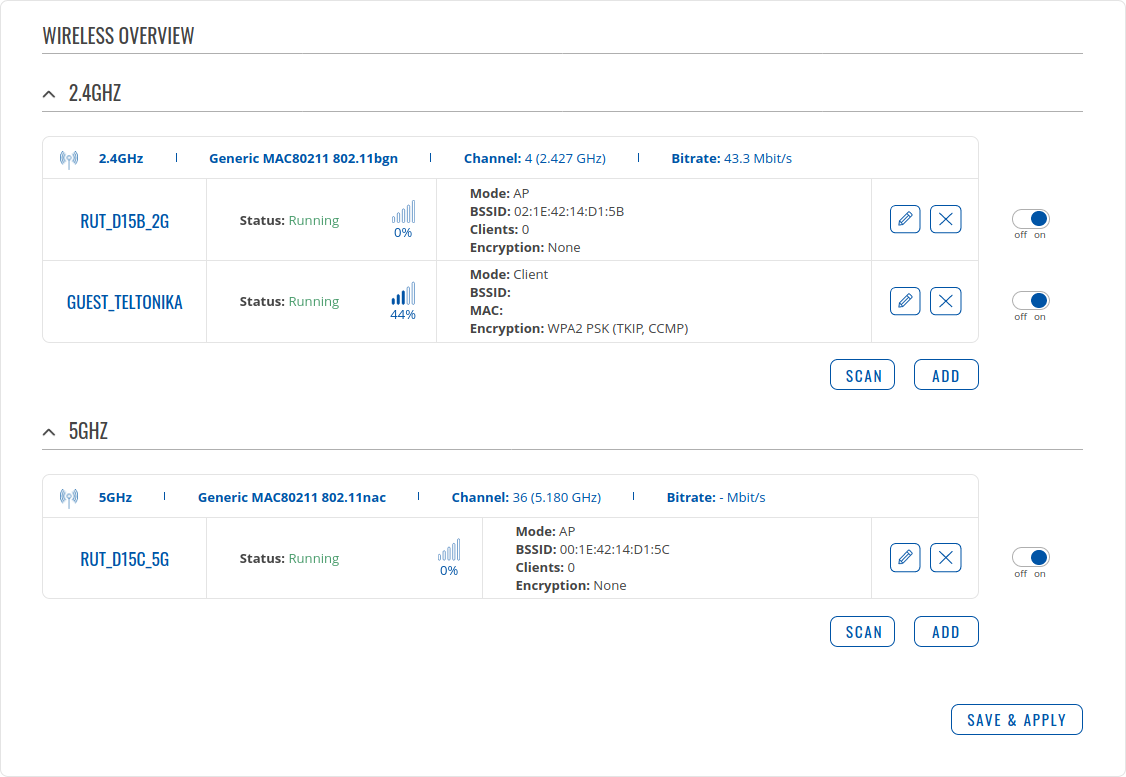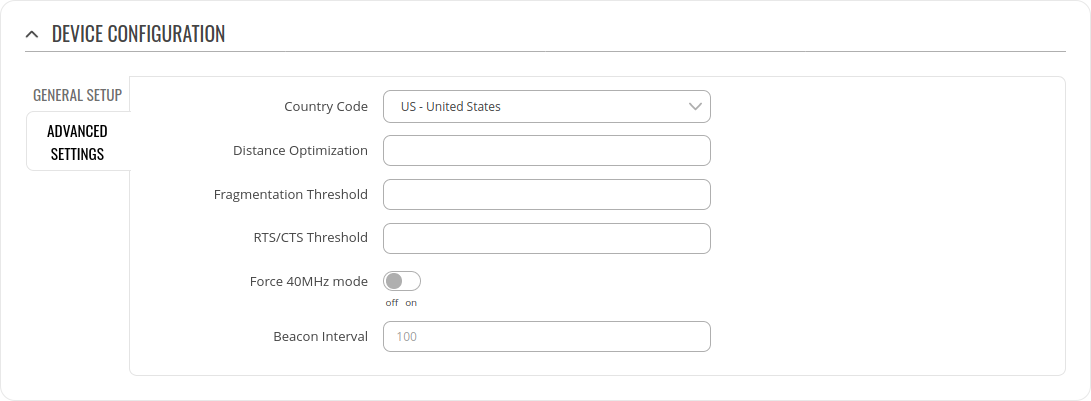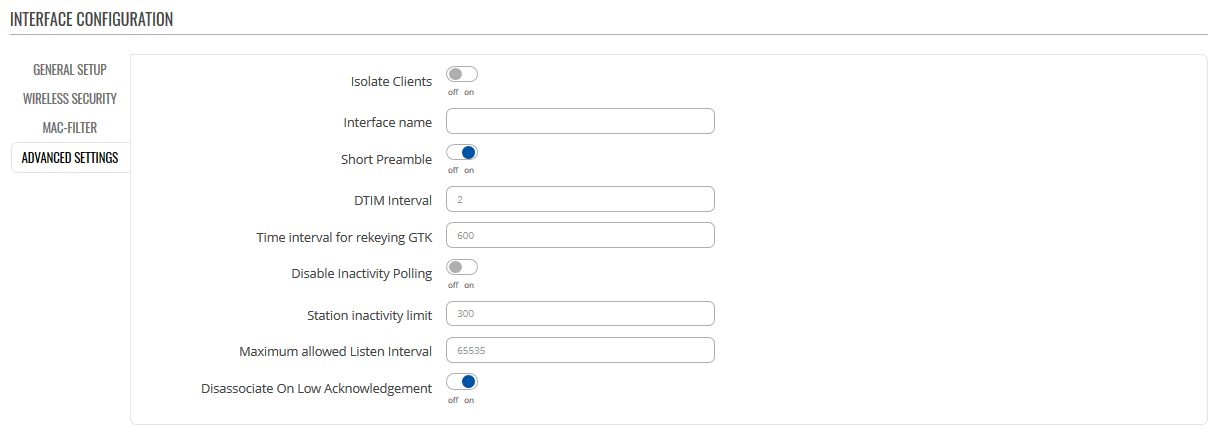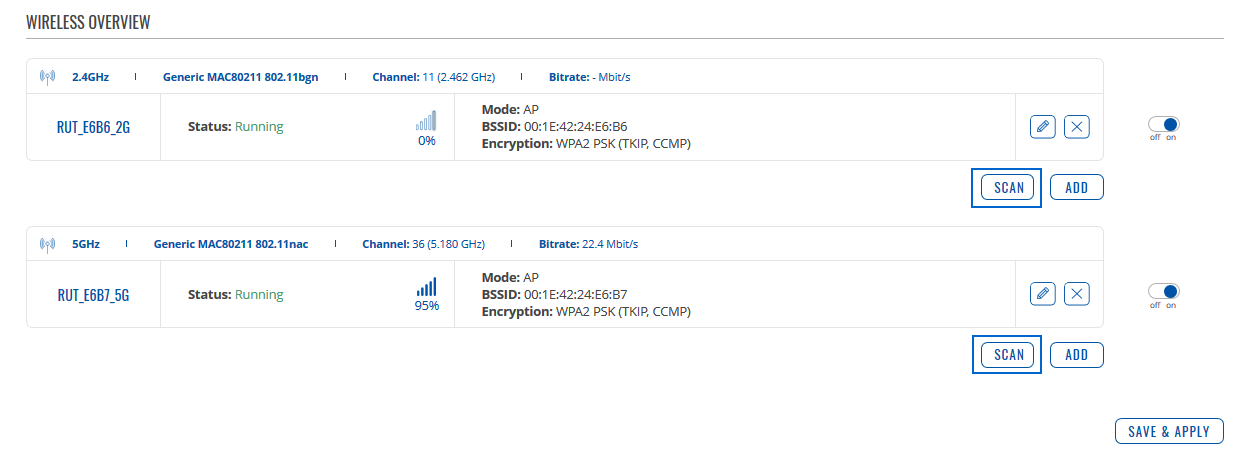Template:Networking rutos manual wireless
Summary
The Wireless section of the Network tab can be used to manage and configure WiFi Access Points and WiFi Stations (clients) . This chapter of the user manual is an overview of the Wireless section of {{{name}}} routers.
Wireless technology
{{{name}}} routers support IEEE 802.11ac (WiFi 5) with data transmission rates up to 867 Mbps (Dual Band, MU-MIMO), 802.11r fast transition.
Wireless Overview
The Wireless Overview window provides you with the possibility to configure your wireless access points and wireless clients in both, 2.4GHz and 5GHz, bands. The Wireless Clients are needed to set up [[{{{name}}} WAN#Wireless WAN|Wireless WAN]] which will become active only when WiFi Client is already set up.

Above is the overview of the Wireless Overview window. It displays active access points and stations. Here you can turn on or off your WiFi interfaces, remove unwanted access points or stations or enter a configuration window for each WiFi interface, where you can configure it more thoroughly.
Wireless Access Point
The Wireless Access Point configuration window is used to make changes to different access points. It is divided into two main sections – device and interface. One is dedicated to configuring hardware parameters, the other – software. To access this window, simply click the edit ![]() button next to the WiFi interface that you wish to configure:
button next to the WiFi interface that you wish to configure:
Device Configuration
The Device Configuration section is used for configuring WiFi hardware parameters.
General Setup
The General Setup tab is used to Enable or Disable an Access Point, to select the wireless channel used by the Access Point and its Transmit Power.
Choose a WiFi channel according to the busyness of other channels. While RUT devices do not provide a function that lets you monitor the usage of nearby WiFi channels, you can download a free WiFi analyzer app on your phone, laptop or other WiFi device. In most countries there are 13 WiFi channels on the 2.4 GHz band (14 in Japan) to choose from. RUT routers' WiFi works on the 2.4 GHz band. A wireless 2.4 GHz WiFi channel requires a signaling band roughly 22 MHz wide, radio frequencies of neighboring channels numbers significantly overlap each other. Many home networks utilize routers that by default run on channel 6 on the 2.4 GHz band. Neighboring WiFi home networks that run over the same channel generate radio interference that can cause significant network performance slowdowns for users. Reconfiguring a network to run on a different wireless channel helps minimize these slowdowns. Therefore, pick a channel with no other active Access Points and preferably one that has no active Access Point on two adjacent channels on each side as well. If you don't feel like doing this, set the Channel field to Auto and the router will pick the least busy channel in your location automatically.
| field name | value | description |
|---|---|---|
| Enable | off | on; Default: on | Toggle WiFi interface on or off |
| Operating Frequency | ||
| Mode (2.4 GHz) | N | Legacy; Default: N | Wireless N (802.11n) supports a maximum theoretical transfer rate of 300mbps with 2 antennas. It can reach up to 450mbps with 3 antennas. Though typical speeds are more accurately around 130mbps. The legacy standards include 802.11a, 802.11b, and 802.11g |
| Mode (5 GHz) | N | AC; Default: AC | Choose between 802.11n and 802.11ac standards |
| Channel (2.4 GHz) | Auto | 1(2412 MHz) | 2(2417 MHz) | 3(2422 MHz) | 4(2427 MHz) | 5(2432 MHz) | 6(2437 MHz) | 7(2442 MHz) | 8(2447 MHz) | 9(2452 MHz) | 10(2457 MHz) | 11(2462 MHz) |; Default: 1(2412 MHz) | A wireless 2.4 GHz WiFi channel requires a signaling band roughly 22 MHz wide, radio frequencies of neighboring channels numbers significantly overlap each other. Therefore, pick a channel with no other active Access Points and preferably one that has no active Access Point on two adjacent channels on each side as well. |
| Channel (5 GHz) | Auto | 36(5180 MHz) | 40(5200 MHz) | 44(5220 MHz) | 48(5240 MHz) | 52(5260 MHz) | 56(5280 MHz) | 60(5300 MHz) | 64(5320 MHz) | 68(5340 MHz) | 72(5360 MHz) | 76(5380 MHz) | 80(5400 MHz) | 84(5420 MHz) | 88(5440 MHz) | 92(5460 MHz) | 96(5480 MHz) | 100(5500 MHz) | 104(5520 MHz) | 108(5540 MHz) | 112(5560 MHz) | 116(5580 MHz) | 120(5600 MHz) | 124(5620 MHz) | 128(5640 MHz) | 132(5660 MHz) | 136(5680 MHz) | 140(5700 MHz) | 144 (5720 MHz) | 149 (5745 MHz) | 153 (5765 MHz) |157 (5785 MHz) | 161 (5805 MHz) | 165 (5825 MHz); Default: 36(5180 MHz) | A wireless 5 GHz WiFi channel also requires a signaling band roughly 22 MHz wide, but since its channel with is 20 MHZ ir overlaps less with neighboring channels, but it is still recommended to pick a channel with no other active Access Points and preferably one that has no active Access Point on two adjacent channels on each side as well. |
| Width (2.4 GHZ) | 20 MHz | 40MHz; Default: 20MHZ | A 40 MHz channel width bonds two 20 MHz channels together, forming a 40 MHz channel width; therefore, it allows for greater speed and faster transfer rates. But not if those channels are crowded with noise and interference. In crowded areas with a lot of frequency noise and interference, a single 20MHz channel will be more stable. 40MHz channel width allows for greater speed and faster transfer rates but it doesn’t perform as well in crowded areas. |
| Width (5 GHz) | 20 MHz | 40 MHz | 80 MHz; Default: 80MHZ | A 40 MHz channel width bonds two 20 MHz channels together, forming a 40 MHz channel width, 8 MHZ channel bonds four 20 MHz cannels; therefore, it allows for greater speed and faster transfer rates. But not if those channels are crowded with noise and interference. In crowded areas with a lot of frequency noise and interference, a single 20MHz channel will be more stable. 80 MHz width channel is faster than 40MHz which is faster than 20 MHz but it doesn’t perform as well in crowded areas. |
| Transmit Power | [6%...100%]; Default: 100% | The transmit power of an access point radio is proportional to its effective range – the higher the transmit power, the more distance that a signal can travel, and/or the more physical materials that it can effectively penetrate and still have data successfully resolved at the receiver. |
Advanced Setup
The Advanced Setup tab is used to configure how the wireless Access Point will work from a hardware perspective.
| field name | value | description |
|---|---|---|
| Country code | country code; Default: US - United States | SO/IEC 3166 alpha2 country codes as defined in ISO 3166-1 standard |
| Distance Optimization | integer [0..65535]; Default: " " | HT Distance to farthest network member in meters. |
| Fragmentation threshold | integer [256..2346]; Default: " " | The smallest packet size that can be fragmented and transmitted by multiple frames. In areas were interference is a problem, setting a lower fragment threshold might help reduce the probability of unsuccessful packet transfers, thus increasing speed |
| RTS/CTS threshold | integer [0..2347]; Default: " " | RTS/CTS (Request to Send/Clear to Send) are mechanisms, used to reduce frame collisions introduced by the hidden node problem. It can help resolve problems arising when several access points are in the same area, contending |
| Force 40MHz mode | off | on; Default: off | Always use 40MHz channels even if the secondary channel overlaps. Using this option does not comply with IEEE 802.11n-2009! |
| Beacon interval | integer [15..65535]; Default: " " | Beacon signal interval in seconds |
Interface Configuration
The Interface Configuration section is used to configure wireless Access Points from the software perspective.
General Setup
The General Setup tab contains basic options for ESSID and network interface.
| field | value | description |
|---|---|---|
| Mode | Access Point | Client; Default: Access Point | Defines what role this interface will do, Access point to supply WiFi for other devices, or as Client to use other devices WiFi for WWAN |
| ESSID | Factorry ESSID is different for every device; Default " " | Extended Service Set Identifier |
| Network | lan | mobile wan | wan; Default: lan | Choose the network(s) you want to attach to this wireless interface or fill out the create field to define a new network. |
| ESSID | off | on; Default: off | Hide extended Service Set Identifier |
| WMM Mode | off | on; Default: on | Wi-Fi Multimedia (WMM), previously known as Wireless Multimedia Extensions (WME), is a subset of the 802.11e wireless LAN (WLAN) specification that enhances quality of service (QoS) on a network by prioritizing data packets according to four categories. |
Wireless Security
The Wireless Security tab is used to determine what kind of encryption your WLAN will use.
WPA (WPA-PSK, WPA2-PSK, WPA-PSK/WPA2-PSK Mixed Mode)
| field name | value | description |
|---|---|---|
| Encryption* | No encryption | WPA-PSK | WPA2-PSK | WPA-PSK/WPA2-PSK mixed mode; Default: WPA2-PSK | The type of WiFi encryption used |
| Cipher | Auto | Force CCMP (AES) | Force TKIP | Force TKIP and CCMP (AES); Default: Force TKIP and CCMP (AES) | An algorithm for performing encryption or decryption |
| Key | string; Default: " " | A custom passphrase used for authentication (at least 8 characters long) |
| Enable key reinstallation (KRACK) countermeasures | off | on; Default off | Complicates key reinstallation attacks on the client side by disabling retransmission of EAPOL-Key frames that are used to install keys. This workaround might cause interoperability issues and reduced robustness of key negotiation especially in environments with heavy traffic load. |
Wired Equivalent Privacy (WEP) is a security algorithm for IEEE 802.11 wireless networks. WEP was the only encryption protocol available to 802.11a and 802.11b devices built before the WPA standard.
| field name | value | description |
|---|---|---|
| Encryption* | Auto | Force CCMP (AES) | Force TKIP | Force TKIP and CCMP (AES); Default: Force TKIP and CCMP (AES) | The type of WiFi encryption used |
| Used Key Slot | Key #1 | Key #2 | Key #3 | Key #4; Default: Auto | Defines which Key will be used for comunication |
| Key #1 | string; Default: " " | First WEP encryption key |
| Key #2 | string; Default: " " | Second WEP encryption key |
| Key #3 | string; Default: " " | Third WEP encryption key |
| Key #4 | string; Default: " " | Fourth WEP encryption key |
MAC Filter
The MAC Filter tab is used for setting up rules that allow or exclude devices with specified MAC addresses from connecting to your WiFi network.
| field name | value | description |
|---|---|---|
| MAC address filter | Disable | Allow listed only | Allow all except listed; Default: Disable | Allow listed only – only allows devices with MAC addresses specified in the MAC list to connect to your WiFi network Allow all except listed - blocks devices with MAC addresses specified in the MAC list from connecting to your WiFi network |
| MAC-List | MAC; Default: " " | List of MAC addresses to be included or excluded from connecting to your WiFi network |
Advanced Settings
| field name | value | description |
|---|---|---|
| Isolate Clients | off | on; Default: of | Prevents WiFi client to client communication on the same subnet |
| Interface name | string; Default: " " | Override default interface name |
| Short Preamble | off | on; Default: on | Uses Short Preamble, it uses shorter data strings that adds less data to transmit the error redundancy check which means that it is much faster. |
| DTIM interval | seconds; Default: " " | Delivery Traffic Indication Message Interval |
| Time interval for rekeying GTK | seconds; Default: " " | Period of time in between automatic changes of the group key, which all devices on the network share |
| Disable Inactivity Polling | off | on; Default: off | Inactivity polling can be disabled to disconnect stations based on inactivity timeout so that idle stations are more likely to be disconnected even if they are still in range of the AP. |
| Station inactivity limit | seconds; Default: " " | Station inactivity limit in seconds: If a station/client does not send anything in st time frame, an empty data frame is sent to it in order to verify whether it is still in range. If this frame is not acknowledged, the station will be disassociated and then deauthenticated. |
| Maximum allowed Listen Interval | integer [0..65535]; Default: " " | Association will be refused if a client/station attempts to associate with a listen interval greater than this value. |
| Disassociate On Low Acknowledgement | off | on; Default: on | Allow AP mode to disconnect stations/clients based on low Acknowledgement condition |
Wireless Client
{{{name}}} can also work as a WiFi client. Configuring client mode is nearly identical to Access Point, except for the fact that most of the options are dictated by the WiFi Access Point that the router is connecting to. Changing them can result in an interrupted connection to that router.
To begin configuring WiFi Client first press Scan button under chosen band (2.4 GHZ or 5 GHZ) to scan the surrounding area and attempt to connect to a new wireless access point.
After which you will be redirected to the window shown below, where you will see list of available WiFi Access Points in the area. Choose one according to your liking and press the Join Network button next to it.
You again will be redirected to following window, where you will need to enter WPA passphrase or other security password depending on AP that you are connecting to, name yours network (it will be name of your wireless WAN interface) and assign firewall rule.
Next window that opens will be Device Configuration. Values there, mostly, should be left unchanged to avoid connection problems, because they are dictated by Access Point. Other than that, only difference from Access Point settings are in Interface Configuration → General Setup section, where Mode is set to Client, and Network attached to this wireless interface is WAN instead of LAN
Click Save & Apply. [[{{{name}}}_Wireless#Wireless_Overview|Wireless Overview]] window with added interface will open. And if you would go to [[{{{name}}} WAN#WAN|WAN]] section of your router you would see new WAN interface.
[[Category:{{{name}}} Network section]]











